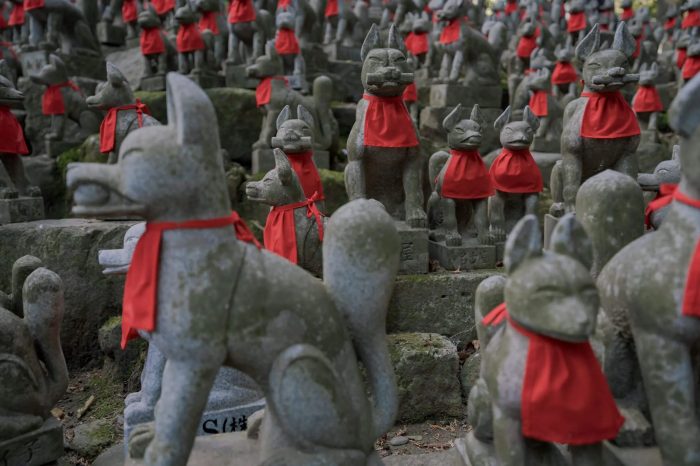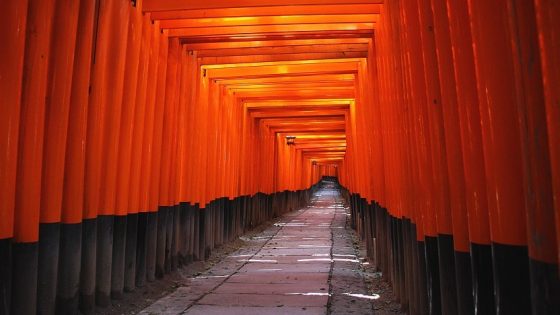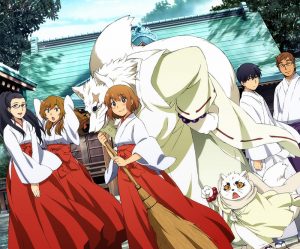
When Japanese shrines appear in anime and games, it’s nice to have some background information about what we are seeing. For a Japanese audience, it’s obvious; they’ve grown up with this as part of their culture. But for foreigners who may not know much about Shintoism or Buddhism, the shrines may just be nothing more than a nice aesthetic.
Today we are going to look at one kind of shrine, Inari shrines, as more than just a cool Japanese setting. Inari shrines are easy to spot in games and anime as they usually have fox statues, because foxes are seen as Inari’s sacred messenger. Inari is also a deity of business prosperity, well-being, and interestingly, rice. We are going to have a look at real Inari shrines, and then at some of their most famous appearances in the otaku world.
Because the deity Inari has been depicted as both male and female throughout time, we will use the singular “they/them” pronoun throughout this article to refer to them.
What are Inari Shrines Anyway?

Inari shrines can be found all over Japan and are used by both Shinto and Buddhist religions. They’re usually red and white, so they’re easy to distinguish from other shrines. Almost always, real Inari shrines are marked by a Torii gate at the entrance as well, as are most sacred spots in Japan, but Inari shrines always have a red gate. Inari shrines date all the way back to the ninth century when Inari was first named the protector of Toji Temple in Kyoto. The worship of Inari spread from Kyoto to the rest of Japan, especially as Inari was seen as a deity for good business and merchants adopted the practise of worshipping them.
Inari shrines typically have many statues of foxes within them, as foxes are seen as the sacred messengers of Inari. Often, these fox statues have been given red scarfs around their necks, and offerings have been left by modern-day followers on Inari before them. Because Inari is also the deity of rice, which is an extremely important part of the Japanese diet and has been for thousands of years, Inari is seen as something to bring prosperity and good health, along with symbolising the miracle of what the Earth can provide. This makes Inari one of the most widely worshipped and followed gods in Japan.
Today, there are more than one thousand Inari shrines throughout Japan. This includes personal shrines within households and businesses, as well as some of Japan’s most ironic shrines, like Fushimi Inari-taisha in Kyoto. If you’ve seen any pictures of real shrines in Japan before, you’ve likely seen Fushimi Inari-taisha at least once.
Featured in Anime AND Games!

Inari shrines are heavily featured in none-other-than the 2014 romance anime Inari, Konkon, Koi Iroha (Inari Kon Kon). In the story, the main character (also named Inari) rescues a fox puppy, and in return, the deity Inari grants her the magical ability to transform her form. She also has a fox spirit guide - both convenient in helping her to confess her love to her crush. A lot of the anime is set in Fushimi Inari Shrine in Kyoto, and even the main character’s name is Inari Fushimi. Today you can even buy souvenir snacks featuring the art of Inari, Konkon, Koi Iroha at Fushimi Inari Shrine!

One of the most recent places Inari shrines have shown up was this past summer’s hit game, Ghost of Tsushima. In the game, there are a lot of historical pieces of Japan to discover, including dozens of Inari shrines hidden all over the open-world map. Players are led to these secret locations by foxes, and the locations feature a few stone fox statues and a small shrine that the character prays to for a stats boost.
The main character, a samurai named Jin Sakai, mentions in the story that he is blessed by Inari, which may be a reason he is successful in his endeavours throughout the game! While you’re unlikely to find a real Inari shrine by being taken there by a fox messenger (unless you are also blessed by Inari, of course), it's cool to see so many beautiful shrines featured in what is already a stunning game.
Final Thoughts
Next time you spot an Inari shrine in anime or a game, you’ll understand its significance a little better. Whether it’s just being used as a setting or background, or actually as a plot point, you can get a deeper meaning out of its placement if you understand a little about its history and meaning. Keep your eyes open for fox statues and red Torii gates in your otaku media - and hopefully someday you can see a real Inari shrine for yourself if you haven’t already!
Have you ever seen a real Inari shrine? Did you know much about them before? Are you going to read even more about them now? Would you like to see other similar articles in the future? Drop us a comment before you leave!
Recommended Post
What is Kitsune? [Definition; Meaning]
Recommended Post
Top 10 Kitsune Boys in Anime
Recommended Post
Top 10 Kitsune Anime [Best Recommendations]
Recommended Post





